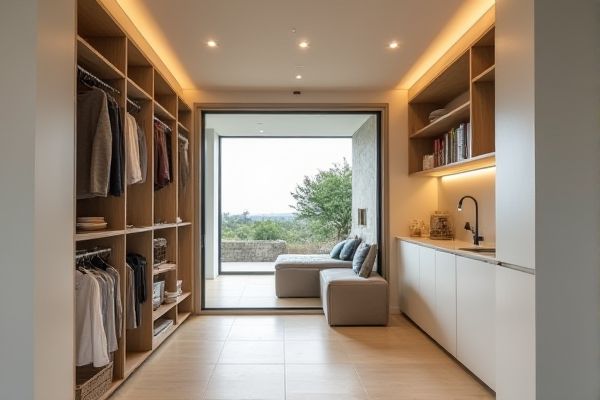
A built-in drying cabinet offers efficient, space-saving drying with controlled temperature and ventilation, ensuring faster and more hygienic drying compared to an open drying rack, which exposes clothes to dust and takes up more room. Discover which drying method best suits Your lifestyle by reading the rest of the article.
Table of Comparison
| Feature | Built-in Drying Cabinet | Open Drying Rack |
|---|---|---|
| Drying Efficiency | High - controlled airflow and temperature | Low to moderate - relies on ambient air and sunlight |
| Space Usage | Compact, wall-mounted or integrated design | Requires floor or outdoor space |
| Protection | Protects clothes from dust, insects, and weather | Exposes clothes to environmental elements |
| Installation | Requires electrical connection and professional setup | No installation needed; portable and easy to set up |
| Drying Time | Fast - accelerates drying with heat and ventilation | Slow - dependent on weather conditions |
| Cost | Higher initial investment and energy consumption | Low cost and no energy usage |
| Maintenance | Requires periodic cleaning and servicing | Minimal maintenance |
| Environmental Impact | Higher energy use; potential carbon footprint | Eco-friendly; zero energy consumption |
Introduction to Laundry Drying Methods
Built-in drying cabinets provide controlled temperature and humidity settings that accelerate fabric drying while minimizing wrinkles and damage, making them ideal for delicate or specialty garments. Open drying racks rely on natural air circulation, enabling gentle drying without heat but can be slower and affected by room conditions such as humidity and airflow. Choosing between these methods depends on factors like fabric care requirements, drying time, available space, and energy consumption preferences.
Overview of Built-in Drying Cabinets
Built-in drying cabinets offer a compact, energy-efficient alternative to open drying racks, providing controlled temperature and humidity settings to safely dry delicate fabrics without the risk of dust or insects. These cabinets integrate seamlessly into laundry rooms, ensuring clothes dry faster while preserving fabric quality compared to air-drying on open racks. Your garments benefit from consistent airflow and gentle heat, reducing wrinkles and the need for ironing.
Features of Open Drying Racks
Open drying racks feature a lightweight, foldable design that allows easy storage and portability, making them ideal for small spaces and quick drying needs. They rely on natural air circulation and sunlight, providing an energy-efficient and eco-friendly drying method without the use of electricity. These racks typically accommodate various clothing sizes and types, offering adjustable rods or tiers to maximize drying capacity and airflow.
Space Efficiency Comparison
A built-in drying cabinet maximizes space efficiency by utilizing vertical storage within existing cabinetry, freeing up floor area and reducing clutter in your laundry room. In contrast, open drying racks occupy significant floor space and can obstruct walkways, making them less practical for smaller or highly-used areas. Choosing a built-in drying cabinet optimizes your space by combining drying functionality with compact, organized design.
Drying Performance and Speed
Built-in drying cabinets offer superior drying performance and speed by circulating warm air evenly around clothes, reducing moisture more efficiently than open drying racks that rely on ambient air and natural evaporation. Your laundry dries faster in a controlled environment, minimizing dampness and the risk of mildew. Open drying racks may extend drying time significantly, especially in high humidity or low ventilation conditions.
Energy Consumption and Sustainability
Built-in drying cabinets typically consume more energy than open drying racks due to their electrical heating elements, which can increase your household's carbon footprint. Open drying racks rely on natural air circulation and ambient temperature, making them a more sustainable choice with zero energy consumption. Choosing an open drying rack aligns better with energy-saving practices and reduces environmental impact compared to the higher electricity demand of drying cabinets.
Impact on Clothing Longevity
A built-in drying cabinet provides controlled temperature and humidity, significantly reducing fabric stress and extending the lifespan of delicate garments compared to open drying racks. Open drying racks expose clothing to fluctuating air quality and potential UV damage, accelerating wear and color fading over time. Choosing a drying cabinet helps maintain your clothing's structural integrity and vibrant appearance longer.
Noise and Maintenance Considerations
Built-in drying cabinets operate quietly with noise levels typically below 40 decibels, making them ideal for indoor use without causing disturbance. Regular maintenance involves cleaning filters and vents every few months to ensure efficient airflow and prevent mold buildup. In contrast, open drying racks produce no mechanical noise but may require more frequent cleaning of surrounding areas due to dripping water and potential mildew on clothes.
Cost and Investment Analysis
Built-in drying cabinets typically require a higher initial investment, ranging from $1,500 to $3,000, compared to the minimal cost of open drying racks, which average between $20 and $100. Long-term energy usage and maintenance costs for drying cabinets can increase overall expenses, while open drying racks incur virtually no operating costs. Homeowners should weigh the upfront price and ongoing expenses of drying cabinets against the affordability and zero energy consumption of open drying racks for cost-effective laundry solutions.
Which Drying Solution is Best for Your Home?
Built-in drying cabinets offer controlled temperature and airflow, reducing drying time and preventing fabric damage, making them ideal for homes with limited space or frequent laundry needs. Open drying racks rely on natural air circulation, saving energy but often requiring more time and space, best suited for delicate items and well-ventilated areas. Choosing the right drying solution depends on your home's layout, laundry volume, and preference for convenience versus energy efficiency.
 homyna.com
homyna.com